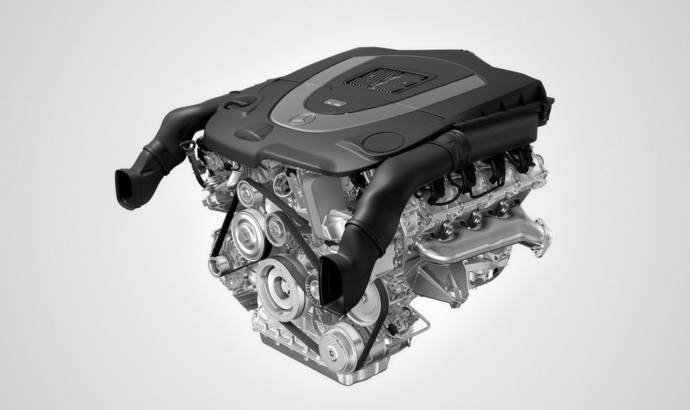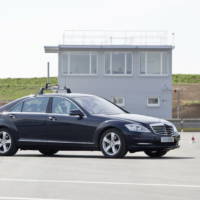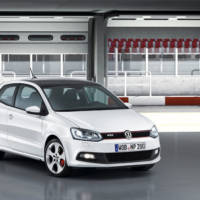Daimler is introducing its new range of V6 and V8 Mercedes engines that are more fuel efficient yet more powerful.
The new 3.5-liter V6 Mercedes engine delivers 306 HP (225 kW) and 370 Nm of torque (20 Nm more than before) while fuel efficiency has been improved to 7.6-litres per 100 Km, which is 24 percent less than its predecessor.
As for the new 4.6-liter V8 Mercedes engine, power output has been increased by 12 percent to 435 HP (320 kW) and 700 Nm of torque (from 530 Nm). The 4.6-litre V8 has a 0.8-litres smaller capacity and fuel consumption has been increased by 32 percent.
To give you some specific numbers, the CL 500 consumed 12.3-litres per 100 Km and had CO2 emissions of 288 g/Km, while the new V8 enables consumption figures of 9.5 litres of fuel per 100 Km and CO2 emissions of 224 g/Km.
More details referring to the new Mercedes 3.5-liter V6 and 4.6-liter V8 engines in the official press release below.
Mercedes press release :
Mercedes-Benz is setting previously unachievable efficiency standards in the premium segment with completely newly developed V6 and V8 engines. The new V8 engine has a displacement of 4663 cc and develops an output of 320 kW (435 hp), which is around 12 percent more than its predecessor despite approx. 0.8 litres less displacement. Torque has increased from 530 Nm to 700 Nm – i.e. by no less than 32 percent. Fuel consumption has however been reduced by 22 percent. With the same 3499 cc displacement as its predecessor, the new V6 engine develops 225 kW (306 hp). Torque has increased from 350 Nm to 370 Nm. Here too, the improvement in fuel efficiency is remarkable. The S 350 with the new V6 engine consumes an economical 7.6 litres per 100 kilometres, a saving of 24 percent compared to its predecessor. Mercedes-Benz has achieved this considerable leap in efficiency with the use of a start/stop function as standard and other features such as newly developed, third-generation direct petrol injection with spray-guided combustion, multiple injection and multi-spark ignition. With this new generation of V-engines, Mercedes-Benz is clearly demonstrating that with concerted further development, internal combustion engines still have a great deal of potential, and that V6 and V8 engines with their great running refinement can continue to be used to good effect in the future.
Considerably less fuel consumption despite a much higher output was the development objective for the new Mercedes-Benz V-engine generation, which will initially be used as an 8-cylinder in the CL-Class, and later in the S-Class from autumn 2010. Mercedes-Benz developed the new six and eight-cylinder units because optimised internal combustion engines continue to have specific advantages over other drive systems with respect to operating range and refuelling time and costs, while offering the greatest short-term potential to achieve significant fuel savings in day-to-day operation.
"The new six and eight-cylinder engines from Mercedes-Benz are a unique synthesis of effortless power delivery, comfort and efficiency," says Dr. Thomas Weber, the member of the Daimler AG Executive Board responsible for corporate research and development at Mercedes-Benz Cars. "Both impress with refinement at the highest level, as well as exemplary environmental compatibility."
The new Mercedes-Benz engine family is uncompromisingly based on modularisation. It allows the use of a start/stop function, 4MATIC all-wheel drive and combination with a hybrid module.
The V8 is in a new league of its own
On the basis of its predecessor, the new V8 has undergone concerted further development. For example, it has a 15-percent smaller displacement (4663 cc rather than 5461 cc) but generates 320 kW (435 hp) and therefore around 12 percent more output than the preceding unit (285 kW/388 hp). Whereas the current CL 500 consumes 12.3 litres per 100 kilometres, this figure drops to 9.5 litres with the new engine – a reduction of 22 percent. CO2 emissions have likewise fallen by 22 percent, from 288 g/km to 224 g/km – an outstanding figure for this performance class. At the same time torque has been raised from 530 Nm to 700 Nm – an increase of 32 percent.
As the high maximum torque is already available from 1800 rpm, the new high-tech V8 already exhibits an outstanding power delivery at low engine speeds, together with smoothness and refinement that is remarkable even for an eight-cylinder.
In the new V8, Mercedes-Benz engineers primarily achieved a high output for a lower displacement by using two turbochargers — one for each bank of cylinders. The chargers were configured to provide high torque even at low engine speeds – compared to the previous engine the result is an increase of more than 40 percent at 2000 rpm. An outstanding 600 Nm is available between 1600 and 4750 rpm. The driver therefore perceives no turbo delay, but experiences the same pleasant and effortless performance from the new V8 as that delivered by a mighty, naturally aspirated 7-litre engine.
The V6 particularly impresses with its low fuel consumption
The new V6 engine is naturally aspirated, and has the potential for future use of a turbocharger thanks to the modular design concept. The most striking change between the new V6 unit and its predecessor is a reduction in the V-angle between the cylinder banks from 90 degrees to 60 degrees. This enabled the balancer shaft countering primary vibrations to be omitted, and as a result the driver registers an outstanding level of comfort.
A completely new intake and exhaust gas system with a variable-resonance intake manifold and optimised airflows was also developed for the new V6. This enabled the output of the 3499 cc engine to be increased to 225 kW (306 hp) (Previous engine of the same displacement in the S-Class: 200 kW/272 hp). Torque has increased from 350 Nm to 370 Nm, and is available between 3500 and 5250 rpm.
The improvement in fuel consumption is particularly remarkable. The S 350 with the new V6 engine consumes just 7.6 litres per 100 kilometres (CO2 emissions: 177 g/km), which makes it 24 percent more economical than its predecessor (10.0 l/100 km). It also makes the new V6 the benchmark in its segment for a comparable output (provisional figures).
Innovative technology makes V6 and V8 engines fit for the future
Both the new V6 and the new V8 from Mercedes-Benz have aluminium crankcases, pistons and cylinder heads. The crankshaft, connecting rods and valves are of special forged steel.
The technology package in the new engine generation includes a number of new developments that are unique in this combination:
* In combination with multi-spark ignition, a further developed, third generation direct fuel injection system with spray-guided combustion and piezo-electric injectors offers further possibilities for fuel savings – in the V8 by means of an improved, homogeneous combustion process, and in the V6 by a new, stratified combustion process with a considerably extended characteristic map and fuel-efficient lean-burn technology.
* In conjunction with start/stop technology, shift point adjustment and specific friction-reducing measures, improvements in day-to-day fuel consumption by more than 20 percent are possible.
* Power consumption by ancillary units has been reduced. These include an optimised water pump with 2nd-generation thermal management, a demand-controlled oil pump, a volume-controlled high-pressure fuel pump and an intelligent generator management system.
Lightweight construction techniques and detailed improvements have also reduced in-engine friction considerably compared to the previous engine.
With its new-generation V-engines, Mercedes-Benz is clearly demonstrating that with concerted further development, internal combustion engines still have a great deal of potential, and that V6 and V8 engines with their high level of refinement are fit for the future.

07 May 2010
2
New Mercedes 3.5-liter V6 and 4.6-liter V8 engines
2 Comments
Comments are closed.



I own a 2010 GLK with a 2.5 v6 engine
when doing a oil change the owner manual says it takes 8 liter when I put this amount in the dipstick shows way too much oil ,is the manual wrong or is the dipstick wrong.
We’ve seen this discussed over at MBWorld with US version. The owners manual capacities may be wrong for 4-Matics. The correct capacity is 7.0 liters (7.4 US quarters). However, check with your dealer. Also note the suction oil extraction through the filler tube.